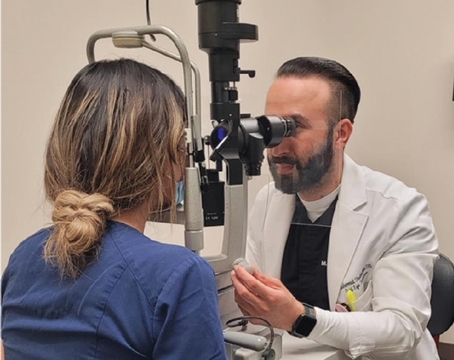For many, the COVID-19 pandemic has been a wake-up call for practices to rethink their operations and efficiency. Doctors and staff alike have devised creative alternatives to meet the needs of the new normal. But what will ophthalmology practices look like in the near future? In this article, we’ll take a closer look at some pandemic-induced changes that may be here to stay.
Patients’ Pull
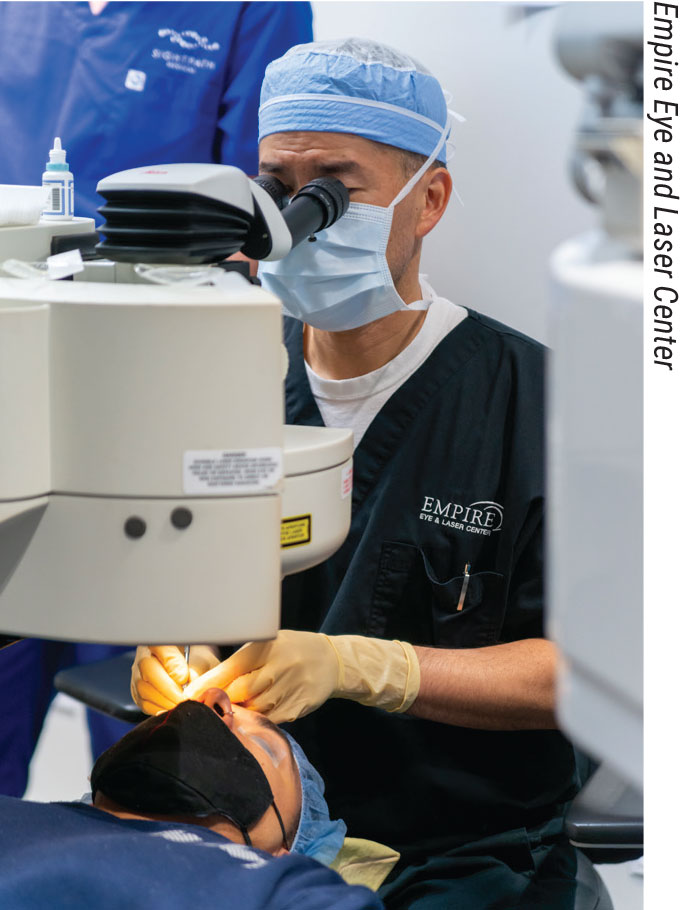 |
|
Daniel Chang, MD, says Empire Surgery Center in Bakersfield, California, now requires both staff and patients to wear masks in the OR. |
James C. Tsai, MD, MBA, a glaucoma specialist and president of the New York Eye and Ear Infirmary of Mount Sinai, Icahn School of Medicine at Mount Sinai, says the pandemic has brought on a sort of paradigm shift in which patients have more influence on how things are done at doctors’ offices.
“Practices have become more conscious of when waiting rooms are packed or busy,” he says. “Patients prefer a socially distanced practice and want more time with their doctor. Many are requesting to reduce the number of times they have to come into our office, which is in New York City. Before, patients would often combine a visit to a practitioner with lunch in the city or a Broadway show, but they’re not doing that right now. Many who live outside the city want to see a local practitioner. Some have their diagnostic tests done at our satellite offices and then do telemedicine with a specialist. I think there may be a swing back to more community-based care.
“These patient desires have been challenging to incorporate,” he continues. “Prior to the pandemic, most offices were set up as very high-volume practices, and now there’s this move to minimize the number of patient visits at the office and offer more telemedicine and remote monitoring. This seems to be the case for most medical specialties.
“Practices used to pack their clinic days, but we’re recognizing that that’s not what patients want,” he says. “At least for the time being, they want to be socially distanced from other patients. This change in patient expectations is coming at an inopportune time, with the CMS reimbursement cuts. The natural response to reimbursements cuts in the past has been to ramp up patient volume, but we might not be able to rely on that as a solution post-COVID.”
Nikola Ragusa, MD, a glaucoma and cataract surgeon at the Bronx Eye Center in New York, says he’s been working longer hours and seeing fewer patients since his practice began scheduling longer appointment slots. “We’ll probably have to maintain this type of schedule for a while,” he says. “We book patients every 15 or 30 minutes, whereas before we were booking patients every 10 minutes or less, and sometimes did double-booking. We just can’t do that anymore.
“Honestly, patients like it,” he says. “They like coming in and being seen right away. I kind of like it too. It’s a little less hectic. We’re generating less revenue, but it makes for a nicer experience. I spend more time talking with patients and don’t feel as if I need to rush to the next one. Because of the staffing shortage, I do some of the technical work myself as well, which leads to even more patient time. The patients have been appreciative. I can take a history while I’m taking their fundus photos or talk to them about other issues. By that time, I have a pretty thorough picture of what’s going on with them. So, while I’m doing more work, there’s also been a positive aspect to all this.”
Shorter Wait Times
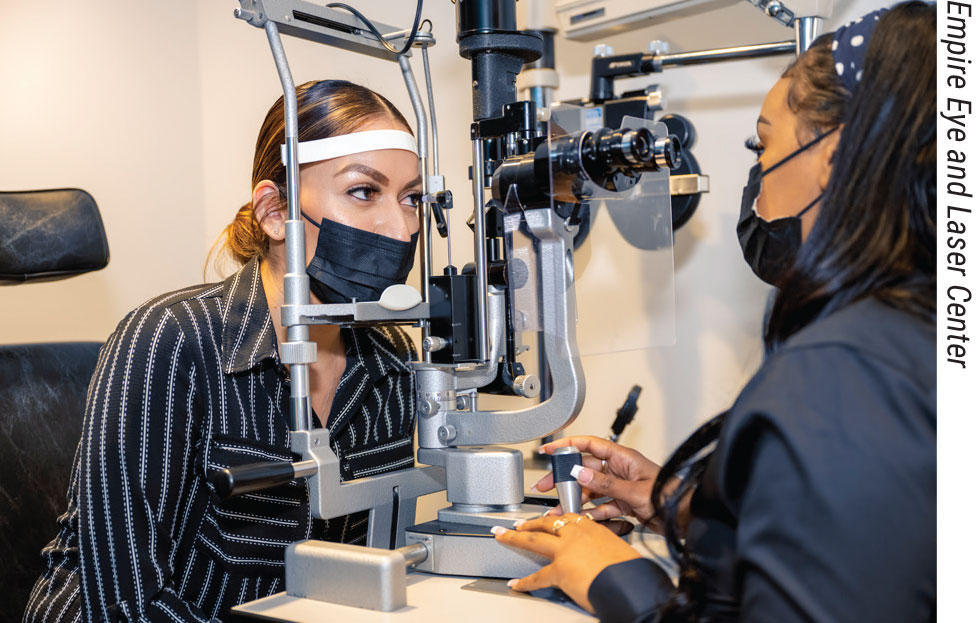 |
|
Many practices say they’ll continue using slit lamp shields and disposable tonometer tips. Pictured: Vanessa Watkin, surgery scheduling coordinator (left) and Saralee Esau, OSC, COA, clinical manager (right) of Empire Eye and Laser Center. |
“Our practice closed for a month when the case numbers were high in March 2020,” says Saralee Esau, OSC, COA, clinical manager of Empire Eye and Laser Center in Bakersfield, California. “Our management team began using Zoom to communicate, and we made a reopening plan for our staff and patients.”
This plan included fully implementing a lean-methodology-based scheduling system for all of their providers. Derived from Taiichi Ohno’s Toyota Production System, lean manufacturing focuses on reducing times within a production system; in a health-care setting, this approach targets areas of inefficiency to improve aspects such as patient waiting times.
Ms. Esau says that implementing a lean scheduling system had been a goal of the company for a while, but the pandemic prompted them to transition sooner. “With this system, we take several factors into consideration when booking appointments, such as the time it takes for a patient to check in at the front desk, the time it takes to get their chart ready, to screen and work them up for a particular exam, to dilate them, and then for the provider to come in and see the patient. Once we began accounting for all of these factors, our office flow became smoother, and we limited patient wait times. We’re trying to have our templates reflect reasonable times that still push our staff to be as efficient as possible.”
During the pandemic, Ms. Esau says this approach helped her practice comply with social distancing while still allowing the practice to see sufficient patient numbers to stay open. She says they’ll continue using the lean system. “We knew it would change our patient volume, but building the time the support staff needs to spend with the patient into the schedule has enabled us to exceed our productivity while also creating a positive experience for our patients. Our reviews have never been better. We feel more prepared to adapt if something similar to the pandemic happens in the future; we’ll still be able to maintain a decent flow of patients.”
“We realized that wait times improve if we avoid putting a patient back in the waiting room between testing and evaluation,” says Natasha Kolomeyer, MD, a glaucoma specialist at Wills Eye Hospital and an assistant professor of ophthalmology at Sidney Kimmel Medical College at Thomas Jefferson University in Philadelphia. “This change involved empowering and training our technicians to care for patients from beginning to end, including testing and making appointments. Additionally, to minimize the amount of time required for patient workup, our technicians have also begun ‘pre-charting.’ This helps if there’s a wait for an empty room. Online forms and the patient portal have also decreased the amount of administrative time.”
Like many other practices, Virginia Eye Consultants, a member of Eye Care Partners, in Norfolk, Virginia, has limited the number of people accompanying a patient during the visit. “This helped to reduce the amount of time patients spend in the clinic,” says practice administrator Teresa Cartwright, COT. “In the past, we allowed several companions, and they usually all had questions for the doctor, which would result in longer wait times and our clinic schedule becoming backed up. We make exceptions if patients need support when changing locations within the clinic and understanding the clinical decision or exam, especially those with mental or physical disabilities.
“We’ve also limited the number of pharmaceutical representatives coming into the clinic,” Ms. Cartwright continues. “Sometimes we’d have four in one day. Now we’re staggering their times and having them notify us when they’ll be in the area, so we don’t have all the doctors’ schedules backed up throughout the day.”
Mobile Testing Devices
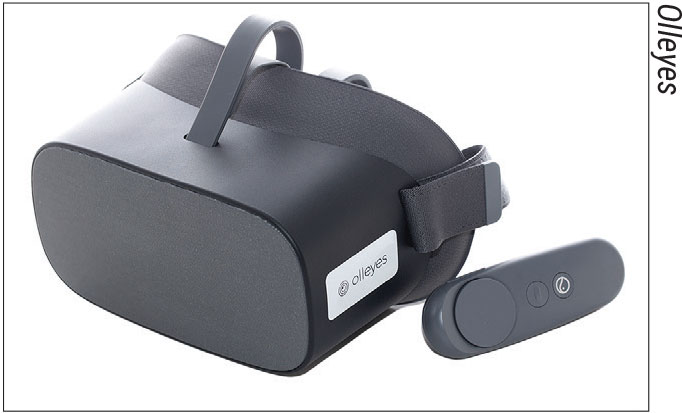 |
|
Wills Eye’s Natasha Kolomeyer, MD, says the VisuaALL virtual reality headset enables patients who have difficulty using a standard perimeter to take their exam in the waiting room. |
Drive-through clinics have largely gone by the wayside, but some of the portable devices used in those clinics, such as handheld tonometers and virtual reality visual field headsets, are still in use on occasion. “At Wills Eye, we’ve started to use virtual reality perimetry for some patients, since it allows patients to take a visual field test while they remain in the exam room,” Dr. Kolomeyer says. Wills Eye uses the VisuALL (Olleyes) and has been a site for the company’s research projects. Protocols such as 10-2, 24-2, 24-2c and 30-2 are available with VisuALL’s visual field perimeter. According to the company, testing time is about three minutes for threshold and 45 seconds for screening.
“We’ve found it useful in patients who are wheelchair-bound, have positioning issues when using the standard perimeter, have other reasons for poor reliability and in cases when the other perimeters are backed up,” she notes. “Frequency of use varies among physicians, and some use it more than others. I find the printouts easy to read, but I’m concerned that the progression analysis will be deficient compared to standard perimetry at this time. Overall, I’m positively surprised by its utility amongst the spectrum of glaucoma patients.”
Safety Precautions
Dr. Tsai says there’s been greater patient awareness of and demand for sanitation procedures since the pandemic’s onset. “I think the patients like to see us incorporating routine intensive cleaning,” he says. “They wonder if there are viral pathogens lurking in the exam room. I don’t believe that patients thought of these issues as much in the past. Our practice is careful to demonstrate to our patients that we’re using good sanitation and safety practices. We make sure providers wash their hands in front of patients, so they know we’re serious about minimizing risk. We also use disposable tips on our Goldmann applanation tonometers whenever possible to reduce the risk of cross-infection.”
“I think most people know not to come in if they aren’t feeling well,” Dr. Ragusa says. “The patients are extremely courteous and don’t want to infect anyone, so we’ve actually been seeing a lot of patients pre-screening themselves and calling in if they’re symptomatic in any way. We’ve been rescheduling them. During the winter months there’s always more patients rescheduling.”
In addition to intensive cleaning protocols and self-screening, many say that slit lamp shields are likely to remain. “Slit lamp shields are just generally a good idea,” says Ms. Esau. “We’re probably going to use them long-term.”
Before the pandemic, Daniel Chang, MD, a cataract and refractive surgeon at Empire Eye and Laser Center and Empire Surgery Center, says only staff wore masks in the OR. Now, patients do too. “We’ve also decided to retain the use of patient and staff masking throughout the entire surgery center instead of just in the OR,” he adds. “Not smelling patients’ breath for the last two years has been an added bonus. The same goes for being at the slit lamp in clinic, when we’re only about 12 inches away from patients’ faces. The state and local mandates still require that we have patients and staff mask in the clinic, but we’ll probably make that optional when regulations allow.”
Though a rare occurrence, if a patient needs to the see the doctor urgently—e.g., if their pressure hasn’t come down or they have a corneal ulcer—and they’re symptomatic or COVID-19-positive, Ms. Cartwright says the doctors at her practice suit up in full PPE and see the patient outside, using portable slit lamps and tonometers. “This doesn’t happen often, but we’re prepared,” she says. “Afterwards, we have a trash can in place for them to take off the PPE and dispose of it. It’s all taken to the dumpster. The doctors wash their hands, put on new masks, and both doctors and technicians change their lab coats before re-entering the clinic. Afterwards, the doctor will call the patient, finish the exam later and document in the chart.”
To ensure patients wear masks properly when entering the facility, Virginia Eye Consultants maintains a greeter at its largest location and surgery center. “Our greeters are often retired individuals who are looking to work a few hours a week part time. Currently, our greeter is a retired Navy veteran who wanted to work a few hours each week to get out of the house,” says Ms. Cartwright. “They direct patients to the proper subspecialty for their appointments, and they don’t let patients enter if they refuse to wear a mask. This has helped us a lot. The greeters prevent patients from having arguments with the front desk staff. We supply a mask if needed. Now, the front desk staff don’t have to take time away from their work and the other patients, and staff members don’t have to hear arguments. The greeters also assist with accepting packages, so we can avoid admitting non-patients into the building. This limits potential exposure.”
Telemedicine
Telemedicine facilitated continuity of care for patients during the throes of the pandemic, but most agree it isn’t quite ready to replace in-office visits. “We haven’t found it as helpful in ophthalmology,” says Dr. Tsai. “At-home monitoring technologies and vision-testing devices aren’t ready for prime time yet, and there’s too much room for error when patients test themselves in their own homes. We can’t confidently confirm the reliability of those tests.”
“We conducted some virtual visits by phone and video during the pandemic, but we haven’t incorporated them into more routine care,” notes Dr. Kolomeyer. “There’s a possibility we may adopt a hybrid model in the future for patients who are stable and established.”
As long as there’s still demand, Ms. Esau says her practice will continue offering telemedicine to patients. “We relied heavily on telemedicine to provide care to patients and maintain our productivity during the pandemic,” she says. “We continue to offer it, though demand has declined.”
Nevertheless, proponents say there’s untapped potential in telemedicine that may be advantageous in the new normal. Dr. Ragusa, who is the co-founder of a telemedicine platform for small- and mid-sized private practices called Pulse, says that though demand for telemedicine in general has fallen off in the eye-care space since the height of the pandemic, it hasn’t gone away completely.
“I believe there’s a role for telemedicine—real-time vision exams and provider-patient communication—that hasn’t been used appropriately,” he says. “Telemedicine has the ability to reduce patient waiting times, increase practice revenue and improve workflow, if the practice is willing to invest the time necessary to educate the patients, staff and providers. Education is really the key. Patients still inquire about it at my practice just from seeing the poster I have in the waiting room, and that shows me there’s an interest on the patient’s end.”
“Telehealth postop visits have helped our clinic flow considerably,” says Ms. Cartwright. “Our physicians each perform about 30 cataract surgery procedures per day. Having the day-one postop visit by telehealth for straightforward cataract surgery patients has made a significant difference in clinic flow.
“We also hired a part-time retired optometrist who works about four to five hours each day calling patients. Patients are administered Diamox following surgery (if appropriate—no sulfa allergies or kidney problems) to aid in lowering intraocular pressure. As a precautionary measure, the surgeon orders brimonidine twice daily in the operative eye for the first week as an added layer of protection to ensure there are no pressure spikes.”
Remote Work
The pandemic catapulted many practices into adopting flexible working arrangements. Jessica Mahlum, who manages the Center for Ophthalmic Optics and Lasers (COOL) Lab at the Casey Eye Institute, Oregon Health & Science University, says the lab and university has adopted a flexible work-from-home policy that’s allowed staff to social distance while continuing to stay productive. She says, “Many staff members agree that the policy provides a better work-life balance. Besides the initial bumps of the unknown, it’s been a great adaptation to a rapidly changing culture.”
Some practices have shifted their administrative employees to full-time remote workers and have begun creating more remote positions. Ms. Esau says, “We didn’t consider remote positions before the pandemic, but now we’re actively pursuing them because we found that doing the administrative work remotely enables us to dedicate more time to patients while they’re in our office.” She says tasks such as medication refills, prior authorizations, triage and emergency calls, insurance verification for surgery and scheduling office visits are well-suited to remote work.
“Our former clinic manager is now in the process of creating positions across the country for people to essentially be their own call centers for our office from their own homes,” she continues. “With people in multiple time zones, we can be efficient during more hours of the day. We also hope to add a remote quality-assurance position to review exam and chart notes; ensure accurate coding, documentation and billing; review medication and prescription histories; and ensure standard procedures are being followed. We hope this will create opportunities for people who’ve lost employment or those who can’t work outside the home.”
Video Meetings
Administrative and management staff report that using Zoom and other online video communication services to conduct meetings has eased the burden of mutual scheduling. “Our management team used to meet in person for everything, and at times, it was challenging to gather everyone together in one place,” says Ms. Esau. “We’re a big team. Leaving support staff whom you’re supervising, in order to attend a meeting offsite, was especially challenging. Zoom is useful for making quick decisions. We’ve also found that using it enables everyone to have access to meetings. It’s made it easier for individuals to contribute, and we can record meetings for those who can’t make it. Sometimes people Zoom in from vacation because they don’t want to miss things, so it’s nice to have that option. We do balance video meetings with in-person meetings though. Some conversations are just better in person.”
Zoom has also found its way into the hiring process. “We’re now offering first-round interviews by Zoom,” Ms. Esau says. “This helps the management team use their time more efficiently as well as conduct more interviews than before. It’s convenient for out-of-town applicants.”
In Search of Staff
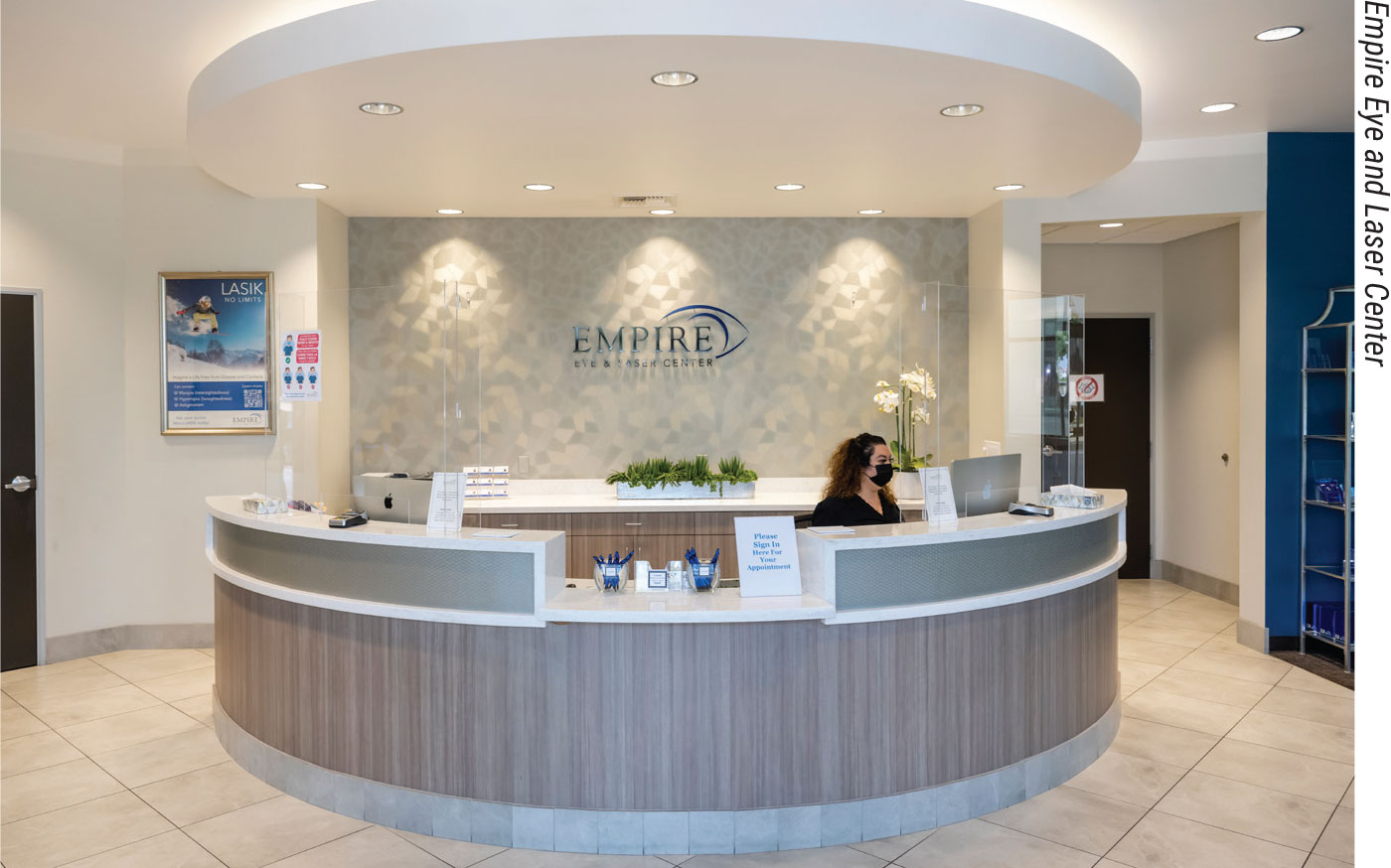 |
| Practices say that patients are more conscious of social distancing and prefer less crowded waiting areas now. Pictured: Angie Ramirez, patient service representative, at Empire Eye and Laser Center. |
Ophthalmic staff have been hard to come by for a long time, but the pandemic brought about unprecedented scarcity. “Many technicians have moved or changed jobs during the pandemic, and some have retired,” says Dr. Tsai. “It’s certainly made it difficult to increase patient volume coming back from the pandemic due to increased staff turnover.”
He says his practice has been reaching out to more potential job candidates. “We’ve also been asking our technicians if they know of any friends or colleagues who’d be interested in working for us. We’ve proactively raised salaries. We value our technical staff, and the last thing we want is for them to feel underappreciated and to start looking elsewhere.”
“I’ve been looking to hire someone at a very competitive wage, but there just don’t seem to be many people around,” Dr. Ragusa says. “Some people come in and say they’re interested, and then you never hear from them again—even those without ophthalmic technician training. It’s just hard to find anybody.”
Because the United States has only 30 accredited technician training programs scattered throughout 16 states and the cost of education can be prohibitive for a high school or community college graduate, some practices and doctors have created their own programs to help meet the demand for trained staff. Palm Beach State College’s program, founded by Robert M. Kershner, MD, MS, FACS, offers an Associate in Science degree in Ophthalmic Medical Technology. The program accepts about 15 students per year and includes two clinical rotations at a variety of externship sites. Dr. Kershner says most program graduates find employment at Bascom Palmer Eye Institute in Miami.
Dr. Kolomeyer says Wills Eye’s new technician training program has been successful. The program consists of 10 evening sessions over the course of five weeks. It’s fairly affordable at $500, which includes training materials. (For comparison, some ophthalmic medical technician training programs at universities cost around $11,000, plus applicable fees, books and supplies.) In the Wills Eye program, students learn how to perform clinical duties, preliminary eye exams and diagnostic procedures to assist the ophthalmologists. All graduates are guaranteed an interview at Wills Eye and receive a bonus after one year if hired. “We try our best to ensure our employees feel appreciated, and we allow them to step into leadership roles as they arise,” she says.
Empire Eye and Laser uses a collaborative style of in-house staff training that helped to withstand pandemic absences. New hires are trained by their department manager and by more senior employees from the same department. Ms. Esau says that cross-training and shadowing in multiple departments across the company enables new hires to gain a well-rounded view of Empire’s mission and processes. “It worked well for us during the pandemic too,” she notes. “Training can be easily affected with just a few absent employees, but with our collaborative approach it’s not just one person providing training. Thankfully, we have a very solid and happy employee base, so we haven’t had many of the pandemic-related staffing woes that others have had.”
Virginia Eye Consultants recently set up an intensive, regimented staff training program. “We hired a Certified Ophthalmic Technician to train staff in all areas, from the front desk to testing technicians and work-up technicians, to onboarding staff in the surgery center,” Ms. Cartwright says.
“If a staff member becomes certified as a COA or COT, they receive a dollar increase in pay as an added incentive,” she continues. “Across the board, and over the past two years, we’ve had multiple pay reviews. We’ll give staff a pay increase later this month. Other incentives include a bonus structure for nurses in the surgery center. We try to maintain and keep our pay level competitive and consistent with other ophthalmic practices across the country to ensure we’re retaining good, well-trained staff without losing them to other facilities. We also have early sign-on bonuses for optometrists and ophthalmologists who commit to staying with us for two years. Hopefully we’ll get back to where we were before the pandemic.”
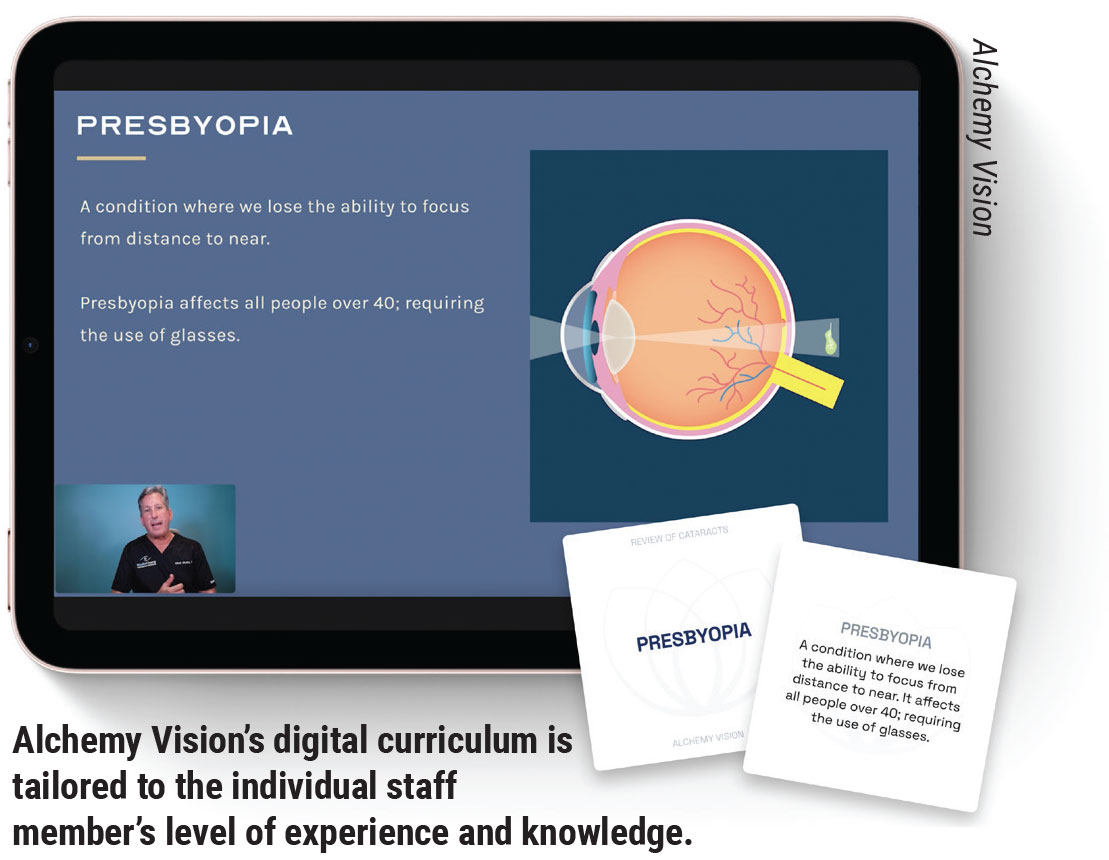 |
One unique training alternative is the web-based, digital-learning platform called Alchemy Vision, which was founded in 2021 to specifically address the staffing and training challenges faced by ophthalmology practices across the country now. Founder and CEO Flora Azucena says that Alchemy Vision provides structured learning using up-to-date materials tailored to the individual’s level of experience and knowledge.
Alchemy Vision’s Entry curriculum is usually incorporated into a new hire’s onboarding process, but it’s suitable for any staff member. “Education is at the heart of what we do,” she says. “Staff receive college-level education from world-class faculty, including Mitchell C. Shultz, MD, I. Paul Singh, MD, Nicole Fram, MD, Eduardo Besser, MD, and Felicia Lew, OD. In about eight to 12 weeks, staff will have learned enough about ophthalmology to be efficient and effective.
“Many practices train new hires in-house with good outcomes, but no two technicians train the same way, and a good technician isn’t necessarily a great instructor,” she notes. “They may also find themselves overwhelmed with the addition of training on top of high patient volume.”
“Frankly, staffing and retaining staff is a challenge right now, and this platform has really been a savior for us,” says Carrie Jacobs, COE, CPSS, executive vice president of operations at Chu Vision Institute. (Her practice has no financial interest in Alchemy Vision.) She says that the program has been a great teaching tool for any staff member new to ophthalmology, from front desk staff to nurses. “The quality is excellent and engaging. There are live weekly deep-dive presentations that take topics to the next level. It’s also accountable. The learning is self-paced, but we as leaders are able to set expectations and benchmarks that are necessary for achieving the goal.”
Ms. Azucena describes Alchemy Vision’s subscription model as, “A Hulu subscription for training your entire technician staff.” Training five employees costs $249 per month; the cost for 10 employees is $349. She says customized packages are available for practices with more than 10 technicians. “We train technicians working in small private practice locations with fewer than five technicians and higher-volume practices with dozens of locations such as Mercy Eye,” Ms. Azucena says. “We also recently launched a pilot program with Kaiser Permanente in Los Angeles.”
Alchemy Vision’s Elevate, a new patient-centered solutions model launching in beta-mode this month, trains advanced communication skills to patient counselors, surgery coordinators and more experienced technicians. “We’re living at a time of volume-oriented medicine, where economic and management pressures force doctors to see more patients per unit of time,” Ms. Azucena says. “We’re teaching skills necessary to be specialized members of the eye-care team, from patient cycle time and building rapport to giving directions for specific products. Many patients need more clarification about their medications than the doctor has time to give. We’re partnering with manufactures to ensure staff receive instruction on the most up-to-date FDA labeling.” (To inquire about becoming a beta-testing site, visit alchemyvision.com/beta.)
The pandemic and resulting outside-the-box thinking have led to some rapid changes in practice operations and care delivery. The patient-care landscape is different now. Dr. Tsai says, “We have to be cognizant of advances in remote monitoring and telemedicine, and we have to continue to innovate.”
“I’m grateful that we were able to navigate through the pandemic the way we have,” says Ms. Esau. “Hopefully it doesn’t take another pandemic for new ideas to come.”
Drs. Chang, Kolomeyer, and Tsai, and Ms. Esau, Cartwright, Jacobs and Mahlum report no relevant financial ties to anything discussed in this article. Dr. Ragusa is the co-founder of Pulse, a telemedicine app.
1. International Council of Accreditation for Allied Ophthalmic Education Programs. Find A Program. http://www.icaccreditation.org/find_a_program/find_a_program.html. Accessed March 25, 2022.

